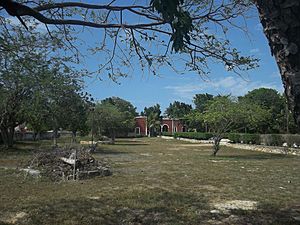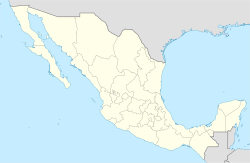Hacienda Chenkú facts for kids
Quick facts for kids
Hacienda Chenkú
|
|
|---|---|
|
Private Residence
|
|

Entrance Hacienda Chenkú, Yucatán
|
|
| Country | Mexico |
| Mexican States | Yucatán |
| Municipalities | Mérida Municipality |
| Time zone | UTC−6 (CST) |
| • Summer (DST) | UTC−5 (CDT) |
| Postal code |
97219
|
| Area code | 999 |
Hacienda Chenkú is a large, old estate located in Mérida Municipality, Yucatán, Mexico. It's like a big farm or ranch that was very important during the 1800s. At that time, many haciendas grew a plant called henequen.
One of the first owners of Hacienda Chenkú was Captain José Ignacio Rivas Chacón in 1788. Later, a famous American archaeologist named Sylvanus Morley lived there in the 1940s.
Contents
What's in a Name?
The name "Chenkú" comes from the ancient Mayan language. "Chen" means "well," and "ku" means "god." So, Chenkú means "the well of god."
Finding the Hacienda
Hacienda Chenkú is easy to find in Mérida. It's located near the northeastern part of the Circuito Colonias road. You can find it in the San Vicente Chuburna neighborhood, on Calle 27 between Calle 30 and 36.
A Look at History
Hacienda Chenkú was first mentioned in records around 1710. Back then, it was a place near an Indigenous village called Chuburna. People used it to raise cattle and keep beehives. In 1788, Captain José Ignacio Rivas Chacón became its owner.
Over the years, the hacienda changed hands many times. In 1903, parts of the property were sold to different people. Later, in 1908, a bank bought Chenkú and another hacienda at a public sale. This happened because the previous owner, Ignacio Duarte Escalante, couldn't pay his mortgage.
In 1913, Vicenta Castilla Molina bought the property from the bank. She later gave it to her children in 1923. Her children, Ignacio and Rosario Molina Castilla, shared ownership for a while. But in 1925, Rosario took full control of the hacienda.
From 1933 to 1949, parts of the hacienda's land were given to local communities. This was part of a big land reform program in Mexico. President Lazaro Cardenas started this program in 1937. It changed haciendas into collective farms called ejidos. This meant landowners could only keep about 150 hectares for private use.
The famous archaeologist Sylvanus G. Morley lived at Chenkú from late 1940 until 1948. He used the hacienda as his base while exploring ancient Mayan sites in Yucatán. He also traveled to and from the United States during this time. His last visit to Chenkú was in May 1948, just before he passed away.
In 1949, Rosario Molina Castilla sold the property to her brother Luis G. Molina Castilla and his wife, Gelitzli Carrillo Palma. Gelitzli was the daughter of Felipe Carrillo Puerto, a very important governor of Yucatán. They later sold it to Alicia Vega de Molina. Three years later, Alicia sold it back to Gelitzli Carrillo Palma and her daughter, Elda E. Molina Carrillo.
In 1954, the State Congress decided to rename the estate "Chenkú de Morley." This was done to honor Sylvanus Morley. He had done so much important archaeological work in Yucatán and written books about the region.
By 1965, the hacienda had new owners. These included José Guy Puerto y Puerto, José María Palomeque Cosgaya, and Humberto Rodríguez Perera. When José Guy Puerto y Puerto passed away, his children inherited his share. They then sold part of their ownership to José María Palomeque Cosgaya.
Today, José María Palomeque Cosgaya owns 50% of the property. Humberto Rodríguez Perera owns 25%, and the Puerto Espinosa family heirs own the remaining 25%. In 1995, the City Council of Mérida declared Chenkú a Cultural Heritage Site. This means it's an important historical place. The hacienda has been partly restored. You can even rent it for photoshoots or parties!
Hacienda Architecture
The main house at Hacienda Chenkú shows off its beautiful colonial architecture. It has a balanced and simple design. The arches at the entrance, the bell tower, and the central staircase all show this balanced style.
The house changed over time. It started as a cattle ranch and later became a henequen plantation. You can see this change because it has arcades (covered walkways with arches) on both the front and back of the house. Inside, you can still find some of the original antique furniture from the hacienda.
Outside, the grounds are lovely. There's a pond in front of the house. The backyard has a large grassy area, many trees, and a swimming pool.
Population Changes
Before 1937, many people lived and worked on the henequen plantations. But after President Lazaro Cardenas's land reform in 1937, things changed. The haciendas became collective farms called ejidos. This meant only the owner's family lived in the main hacienda house.
The 1970 census by the INEGI counted 68 people living at Chenkú. Since then, the people living there are counted as part of the larger City of Mérida population.
| Year | 1900 | 1910 | 1921 | 1930 | 1940 | 1950 | 1960 | 1970 |
|---|---|---|---|---|---|---|---|---|
| Population | 351 | 233 | 117 | 126 | 57 | 45 | 52 | 68 |
Images for kids
See also
 In Spanish: Chenkú para niños
In Spanish: Chenkú para niños










